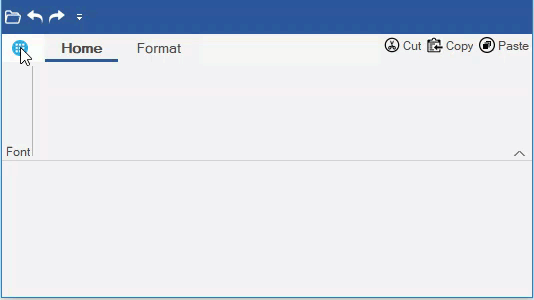The Application Menu is located towards the top-left corner of the ribbon control. This application menu button when clicked displays a dropdown menu of specific commands that can be performed on the entire application such as Open, Close, Save, Save As, Print etc.
The GIF below shows the UI of the Application Menu.

The following section discusses configuring Application Menu and adding items to the drop-down.
Configuring the Application Menu button
The user may note that when the C1Ribbon control is dropped on the Form, it contains by default an Application Menu button, a tab and group. This Application Menu button can be displayed using text, image, or a combination of both.
The user can customize the Application menu and its appearance at design time by using the floating toolbar. New items can be added to the Application Menu at design time via the Collection Editors of C1Ribbon or RibbonApplicationMenu. Refer this topic for more details. You can also customize the look of Application Menu by setting the Text and IconSet properties in the Properties Window.
Programmatically, the Application Menu button can be configured using the ApplicationMenu property of C1Ribbon class and the IconSet property of RibbonIconItem class. The icon of the menu button can be configured using the Source property of C1BitmapIcon class and Size property of C1Icon class.
This is depicted in the code snippet below:
Adding Items to Application Menu drop-down
The commands in the Application Menu dropdown can be customized through the designer as well as code. They can be arranged on the menu using Floating Toolbar and Collection Editors at design-time. This lets the user arrange the commands in the left, right or bottom pane of the Application Menu.
The user can also add commands in the Application Menu through code. This can be done by creating new instances of the ribbon buttons, using the RibbonButton class. These buttons can then be added to the menu dropdown using LeftPaneItems, RightPaneItems and BottomPaneItems properties of the RibbonApplicationMenu class.
This is depicted in the code snippet below: